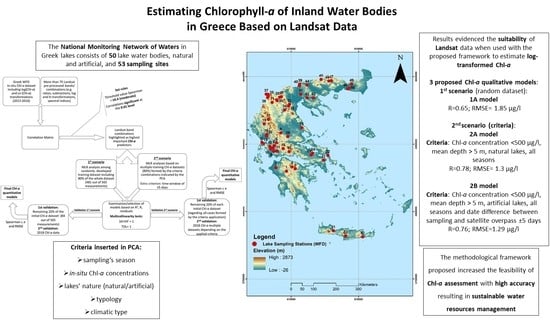Estimating Chlorophyll-a of Inland Water Bodies in Greece Based on Landsat Data
Abstract
1. Introduction
2. Materials and Methods
2.1. Study Area
2.2. Data Acquisition
2.2.1. In Situ Data
2.2.2. EO Data
2.3. Satellite Data Pre-Processing
- Conversion of images from digital numbers (DN) to the physical measure of top-of-atmosphere reflectance (TOA).
- Atmospheric correction using the DOS1 method (Dark Object Subtraction 1; image-based technique), which was applied to all bands except for thermal ones.
- Creation of a band stack set for each image. The band stack set of L7 ETM+ includes the bands B1 (blue), B2 (green), B3 (red), B4 (NIR), B5 (SWIR1), and B7 (SWIR2), while L8 set incorporates bands B2 (blue), B3 (green), B4 (red), B5 (NIR), B6 (SWIR1), and B7 (SWIR2).
2.4. Statistical Methods of Analysis
2.4.1. Basic Statistics and PCA
2.4.2. Developing Relationships between Landsat and Chlorophyll-a Data
2.4.3. Validation Approach
3. Results
3.1. Statistical Analyses
3.2. Relationships between Landsat and Chlorophyll-a Data
3.3. Regression Model Validation
4. Discussion
- An uncertainty of accuracy regarding the location of sampling points. Sampling in lakes requires special attention as winds and other external factors (e.g., season, lake depth and changes in water level, ease of proximity) contribute to potential transpositions of sampling sites.
- The implementation of the DOS1 atmospheric correction method was not validated in order to assure that atmosphere biases were completely removed. However, this method is widely used by the EO community and proved useful when no atmospheric measurements are available.
- Optimal models were applied to lake surfaces accrued from lake shapefiles, acquired from the Environment and Energy Ministry’s website. Since no classification between land and water was conducted, there is the possibility that some pixels, covering land, hindered Chl-a quantification with great accuracy.
5. Conclusions
Author Contributions
Funding
Acknowledgments
Conflicts of Interest
References
- Alymkulova, B.; Abuduwaili, J.; Issanova, G.; Nahayo, L. Consideration of Water Uses for Its Sustainable Management, the Case of Issyk-Kul Lake, Kyrgyzstan. Water 2016, 8, 298. [Google Scholar] [CrossRef]
- Ramsar Convention Bureau. Wetlands Values and Functions; Ramsar Convention Bureau: Gland, Switzerland, 2001. [Google Scholar]
- Gholizadeh, M.; Melesse, A.; Reddi, L. A comprehensive review on water quality parameters estimation using remote sensing techniques. Sensors 2016, 16, 1298. [Google Scholar] [CrossRef] [PubMed]
- Duan, W.; Takara, K.; He, B.; Luo, P.; Nover, D.; Yamashiki, Y. Spatial and temporal trends in estimates of nutrient and suspended sediment loads in the Ishikari river, Japan, 1985 to 2010. Sci. Total Environ. 2013, 461, 499–508. [Google Scholar] [CrossRef] [PubMed]
- Duan, W.; He, B.; Takara, K.; Luo, P.; Nover, D.; Sahu, N.; Yamashiki, Y. Spatiotemporal evaluation of water quality incidents in Japan between 1996 and 2007. Chemosphere 2013, 93, 946–953. [Google Scholar] [CrossRef] [PubMed]
- Whyte, A.; Feredinos, K.; Petropoulos, G.P. A new synergistic approach for monitoring wetlands using Sentinels -1 and 2 data with object-based machine learning algorithms. Environ. Modell. Software 2018, 104, 40–57. [Google Scholar] [CrossRef]
- MacKay, H.; Finlayson, C.M.; Fernández-Prieto, D.; Davidson, N.; Pritchard, D.; Rebelo, L.M. The role of earth observation (EO) technologies in supporting implementation of the Ramsar convention on wetlands. J. Environ. Manag. 2009, 90, 2234–2242. [Google Scholar] [CrossRef]
- Topp, S.; Pavelsky, T.; Jensen, D.; Simard, M.; Ross, M. Research trends in the use of remote sensing for inland water quality science: Moving towards multidisciplinary applications. Water 2020, 12, 169. [Google Scholar] [CrossRef]
- El-Din, M.S.; Gaber, A.; Koch, M.; Ahmed, R.S.; Bahgat, I. Remote sensing application for water quality assessment in lake Timsah, Suez canal, Egypt. J. Remote Sens. Technol. 2013, 1, 61–74. [Google Scholar] [CrossRef]
- Giardino, C.; Bresciani, M.; Cazzaniga, I.; Schenk, K.; Rieger, P.; Braga, F.; Matta, E.; Brando, V.E. Evaluation of multi-resolution satellite sensors for assessing water quality and bottom depth of lake Garda. Sensors 2014, 14, 24116–24131. [Google Scholar] [CrossRef]
- Ritchie, J.C.; Zimba, P.V.; Everitt, J.H. Remote sensing techniques to assess water quality. Photogramm. Eng. Remote Sens. 2003, 69, 695–704. [Google Scholar] [CrossRef]
- Gitelson, A.A.; Dall’Olmo, G.; Moses, W.; Rundquist, D.C.; Barrow, T.; Fisher, T.R.; Gurlin, D.; Holz, J. A simple semi-analytical model for remote estimation of chlorophyll-a in turbid waters: Validation. Remote Sens. Environ. 2008, 112, 3582–3593. [Google Scholar] [CrossRef]
- Olmanson, L.G.; Bauer, M.E.; Brezonik, P.L. A 20-year Landsat water clarity census of Minnesota’s 10,000 lakes. Remote Sens. Environ. 2008, 112, 4086–4097. [Google Scholar] [CrossRef]
- Markogianni, V.; Kalivas, D.; Petropoulos, G.; Dimitriou, E. an appraisal of the potential of Landsat 8 in estimating chlorophyll-a, ammonium concentrations and other water quality indicators. Remote Sens. 2018, 10, 1018. [Google Scholar] [CrossRef]
- Nas, B.; Karabork, H.; Ekercin, S.; Berktay, A. Assessing water quality in the Beysehir lake (Turkey) by the application of GIS, geostatistics and remote sensing. In Proceedings of the 12th World Lake Conference, (Taal 2007), Jaipur, India, 29 October–2 November 2007; p. 646. [Google Scholar]
- Zhang, C.; Han, M. Mapping chlorophyll-a concentration in Laizhou bay using Landsat 8 OLI data. In Proceedings of the 36th IAHR World Congress, Hague, The Netherlands, 28 June–3 July 2015. [Google Scholar]
- Kim, S.I.; Kim, H.C.; Hyun, C.U. High resolution ocean color products estimation in Fjord of Svalbard, Arctic sea using Landsat-8 OLI. Korean J. Remote Sens. 2014, 30, 809–816. [Google Scholar] [CrossRef]
- Lim, J.; Choi, M. Assessment of water quality based on Landsat 8 operational land imager associated with human activities in Korea. Environ. Monit. Assess. 2015, 187, 1–17. [Google Scholar] [CrossRef]
- Bonansea, M.; Rodriguez, C.; Pinotti, L. Assessing the potential of integrating Landsat sensors for estimating chlorophyll-a concentration in a reservoir. Hydrology Res. 2018, 49, 1608–1617. [Google Scholar] [CrossRef]
- Dekker, A.; Peters, S. The use of the thematic mapper for the analysis of eutrophic lakes: A case study in the Netherlands. Int. J. Remote Sens. 1993, 14, 799–821. [Google Scholar] [CrossRef]
- George, D. The airborne remote sensing of phytoplankton chlorophyll in the lakes and tarns of the english lake district. Int. J. Remote Sens. 1997, 18, 1961–1975. [Google Scholar] [CrossRef]
- Ritchie, J.C.; Cooper, C.M.; Schiebe, F.R. The relationship of MSS and TM digital data with suspended sediments, chlorophyll, and temperature in Moon lake, Mississippi. Remote Sens. Environ. 1990, 33, 137–148. [Google Scholar] [CrossRef]
- Gitelson, A.; Mayo, M.; Yacobi, Y.Z.; Parparov, A.; Berman, T. The use of high-spectral-resolution radiometer data for detection of low chlorophyll concentrations in lake Kinneret. J. Plankton Res. 1994, 16, 993–1002. [Google Scholar] [CrossRef]
- Matthews, M.W.; Bernard, S.; Robertson, L. An algorithm for detecting trophic status (chlorophyll-a), cyanobacterial-dominance, surface scums and foating vegetation in inland and coastal waters. Remote Sens. Environ. 2012, 124, 637–652. [Google Scholar] [CrossRef]
- Le, C.; Li, Y.; Zha, Y.; Wang, Q.; Zhang, H.; Yin, B. Remote sensing of phycocyanin pigment in highly turbid inland waters in lake Taihu, China. Int. J. Remote Sens. 2011, 32, 8253–8269. [Google Scholar] [CrossRef]
- Peppa, M.; Vasilakos, C.; Kavroudakis, D. Eutrophication monitoring for lake Pamvotis, Greece, using sentinel-2 data. ISPRS Int. J. Geo-Inf. 2020, 9, 143. [Google Scholar] [CrossRef]
- Markogianni, V.; Dimitriou, E.; Karaouzas, I. Water quality monitoring and assessment of an urban mediterranean lake facilitated by remote sensing applications. Environ. Monit. Assess. 2014, 186, 5009–5026. [Google Scholar] [CrossRef] [PubMed]
- Kontopoulou, E.; Kolokoussis, P.; Karantzalos, K. Water quality estimation in greek lakes from Landsat 8 multispectral satellite data. Special Issue: 10th Word Congress on Water Resources and Environment (EWRA2017—Issue II). Eur. Water 2017, 58, 191–196. [Google Scholar]
- Mavromati, E.; Kagalou, I.; Kemitzoglou, D.; Apostolakis, A.; Tsiaoussi, D. Linkages between physicochemical status and hydromorphology in greek lakes under WFD policy. European Water Resources Association. Special Issue: 10th Word Congress on Water Resources and Environment (EWRA2017—Issue II). Eur. Water 2017, 58, 273–279. [Google Scholar]
- Mavromati, E.; Kagalou, I.; Kemitzoglou, D.; Apostolakis, A.; Seferlis, M.; Tsiaoussi, V. Relationships among land use patterns, hydromorphological features and physicochemical parameters of surface waters: WFD lake monitoring in Greece. Environ. Process. 2018, 5 (Suppl. S1), 139–151. [Google Scholar] [CrossRef]
- Zacharias, I.; Bertachas, I.; Skoulikidis, N.; Koussouris, T. Greek lakes: Limnological overview. Lakes Reservoirs Res. Manag. 2002, 7, 55–62. [Google Scholar] [CrossRef]
- American Public Health Association (APHA). Standard Methods for the Examination of Water and Wastewater, 17th ed.; American Public Health Association: Washington, DC, USA, 1989. [Google Scholar]
- Peel, M.C.; Finlayson, B.L.; McMahon, T.A. Updated world map of the Köppen-Geiger climate classification. Hydrol. Earth Syst. Sci. 2007, 11, 1633–1644. [Google Scholar] [CrossRef]
- Olmanson, L.; Brezonik, P.; Finlay, J.; Bauer, M. Comparison of Landsat 8 and Landsat 7 for regional measurements of cdom and water clarity in lakes. Remote Sens. Environ. 2016, 185, 119–128. [Google Scholar] [CrossRef]
- Loveland, T.; Dwyer, J. Landsat: Building a strong future. Remote Sens. Environ. 2012, 122, 22–29. [Google Scholar] [CrossRef]
- Tebbs, E.; Remedios, J.; Harper, D. Remote sensing of chlorophyll-a as a measure of cyanobacterial biomass in lake Bogoria, a hypertrophic, saline–alkaline, flamingo lake, using Landsat ETM+. Remote Sens. Environ. 2013, 135, 92–106. [Google Scholar] [CrossRef]
- Bonansea, M.; Bazán, R.; Ledesma, C.; Rodriguez, C.; Pinotti, L. Monitoring of regional lake water clarity using Landsat imagery. Hydrol. Res. 2015, 46, 661–670. [Google Scholar] [CrossRef]
- QGIS Development Team. QGIS Geographic Information System. Open Source Geospatial Foundation Project. Available online: http://qgis.osgeo.org/ (accessed on 1 June 2019).
- Congedo, L.; Semi-automatic Plugin Documentation. Release 6.2.0.1. February 2019. Available online: https://fromgistors.%20blogspot.com/p/user-manual.html (accessed on 1 May 2019).
- Matthews, M. A current review of empirical procedures of remote sensing in inland and near-coastal transitional waters. Int. J. Remote Sens. 2011, 32, 6855–6899. [Google Scholar] [CrossRef]
- Liu, H.Q.; Huete, A.R. A feedback based modification of the NDVI to minimize canopy background and atmospheric noise. IEEE Trans. Geosci. Remote Sens. 1995, 33, 457–465. [Google Scholar] [CrossRef]
- Baret, F.; Guyot, G. Potentials and limits of vegetation indices for LAI and PAR assessment. Remote Sens. Environ. 1991, 35, 161–173. [Google Scholar] [CrossRef]
- McFeeters, S.K. The use of the Normalized Difference Water Index (NDWI) in the delineation of open water features. Int. J. Remote Sens. 1996, 17, 1425–1432. [Google Scholar] [CrossRef]
- Xu, H. Modification of Normalized Difference Water Index (NDWI) to Enhance Open Water Features in Remotely Sensed Imagery. Int. J. Remote Sens. 2006, 27, 3025–3033. [Google Scholar] [CrossRef]
- Gitelson, A.A.; Kaufman, Y.J.; Merzlyak, M.N. Use of a green channel in remote sensing of global vegetation from EOS-MODIS. Remote Sens. Environ. 1996, 58, 289–298. [Google Scholar] [CrossRef]
- Rouse, J.W.; Haas, R.H.; Schell, J.A.; Deering, D.W. Monitoring Vegetation Systems in the Great Plains with ERTS; NASA SP-351; NASA: Washington, DC, USA, 1974; Volume 1, pp. 309–317. [Google Scholar]
- Alawadi, F. Detection of surface algal blooms using the newly developed algorithm surface algal bloom index (SABI). In Proceedings of the International Society for Optics and Photonics, Toulouse, France, 12 June 2010; Volume 7825, pp. 1–14. [Google Scholar]
- Dancey, C.P.; Reidy, J. Statistics without Maths for Psychology, 4th ed.; Pearson Education: Harlow, UK, 2007. [Google Scholar]
- Kloiber, S.; Brezonik, P.; Olmanson, L.; Bauer, M. A Procedure for regional lake water clarity assessment using Landsat multispectral data. Remote Sens. Environ. 2002, 82, 38–47. [Google Scholar] [CrossRef]
- McKinna, L.; Werdell, P. Approach for identifying optically shallow pixels when processing ocean-color imagery. Opt. Express 2018, 26, A915–A928. [Google Scholar] [CrossRef] [PubMed]
- Schindler, W.D.; Hecky, E.R.; Findlay, L.D.; Stainton, P.M.; Parker, R.B.; Paterson, J.M.; Beaty, G.K.; Lyng, M.; Kasian, S.E.M. Eutrophication of lakes cannot be controlled by reducing nitrogen input: Results of a 37-year whole-ecosystem experiment. Proc. Natl. Acad. Sci. USA 2008, 105, 11254–11258. [Google Scholar] [CrossRef] [PubMed]
- Sakamoto, M. Primary production by phytoplankton community in some japanese lakes and its dependence on lake depth. Archiv Hydrobiol. 1966, 62, 1–28. [Google Scholar] [CrossRef]
- Jones, J.R.; Bachmann, R.W. Prediction of phosphorus and chlorophyll levels in lakes. J. Water Pollut. Control Fed. 1976, 48, 2176–2182. [Google Scholar]
- Canfield, D.E., Jr. Prediction of Total Phosphorus Concentrations and Trophic States in Natural and Artificial Lakes: The Importance of Phosphorus Sedimentation. Ph.D. Thesis, Retrospective Theses and Dissertations, Iowa State University, Ames, IA, USA, 1979. [Google Scholar]
- Canfield, D., Jr.; Bachmann, R. Prediction of total phosphorus concentrations, chlorophyll a, and secchi depths in natural and artificial lakes. Can. J. Fish. Aquat. Sci. 1981, 38, 414–423. [Google Scholar] [CrossRef]
- Barrett, D.; Frazier, A. Automated method for monitoring water quality using Landsat imagery. Water 2016, 8, 257. [Google Scholar] [CrossRef]
- Dekker, A.G.; Malthus, T.J.; Seyhan, E. Quantitative modeling of inland water quality for high-resolution MSS systems. IEEE Trans. Geosci. Remote Sens. 1991, 29, 89–95. [Google Scholar] [CrossRef]
- Lin, S.; Novitski, L.N.; Qi, J.; Stevenson, R.J. Landsat TM/ETM+ and machine-learning algorithms for limnological studies and algal bloom management of inland lakes. J. Appl. Remote Sens. 2018, 12, 1. [Google Scholar] [CrossRef]
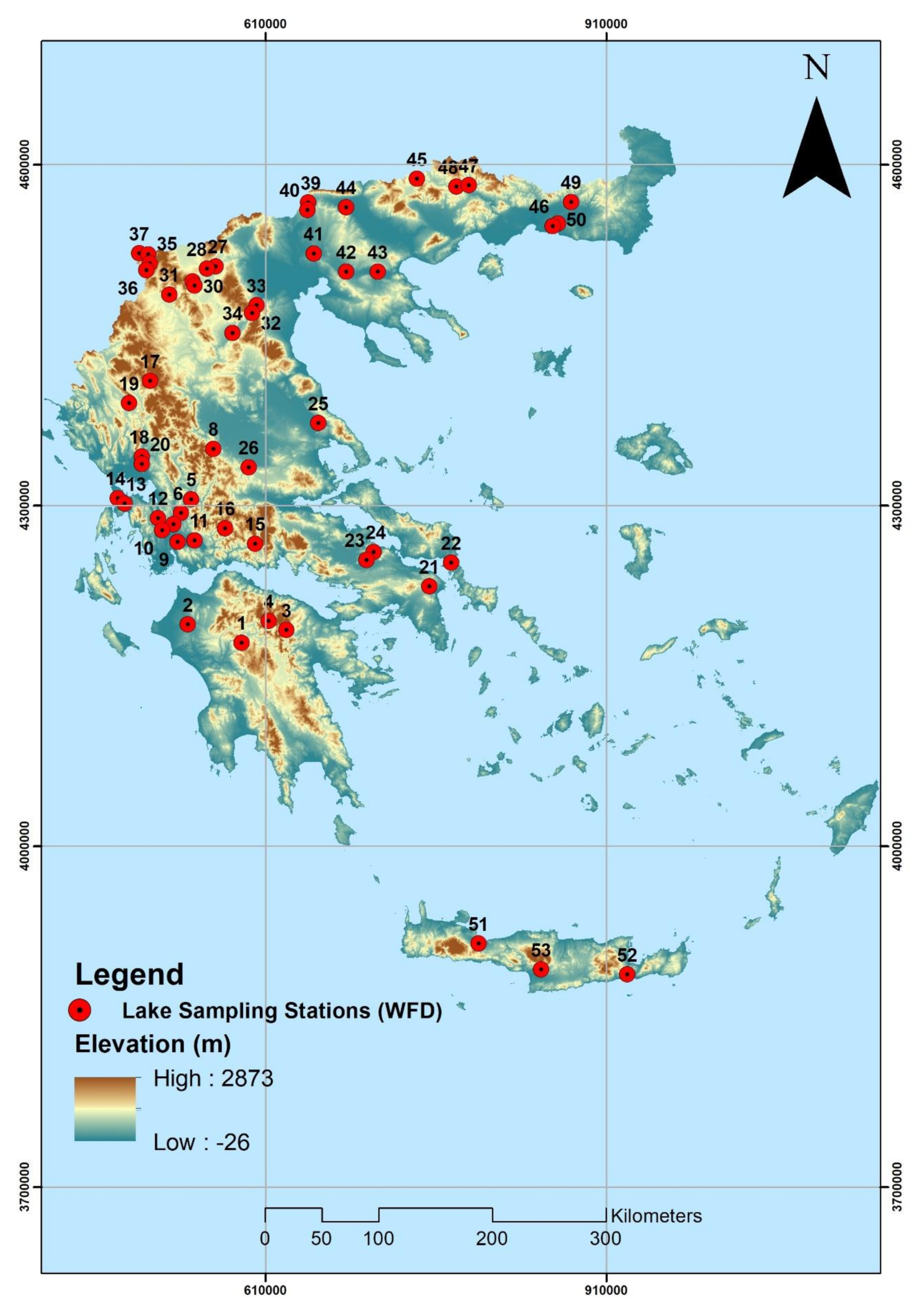
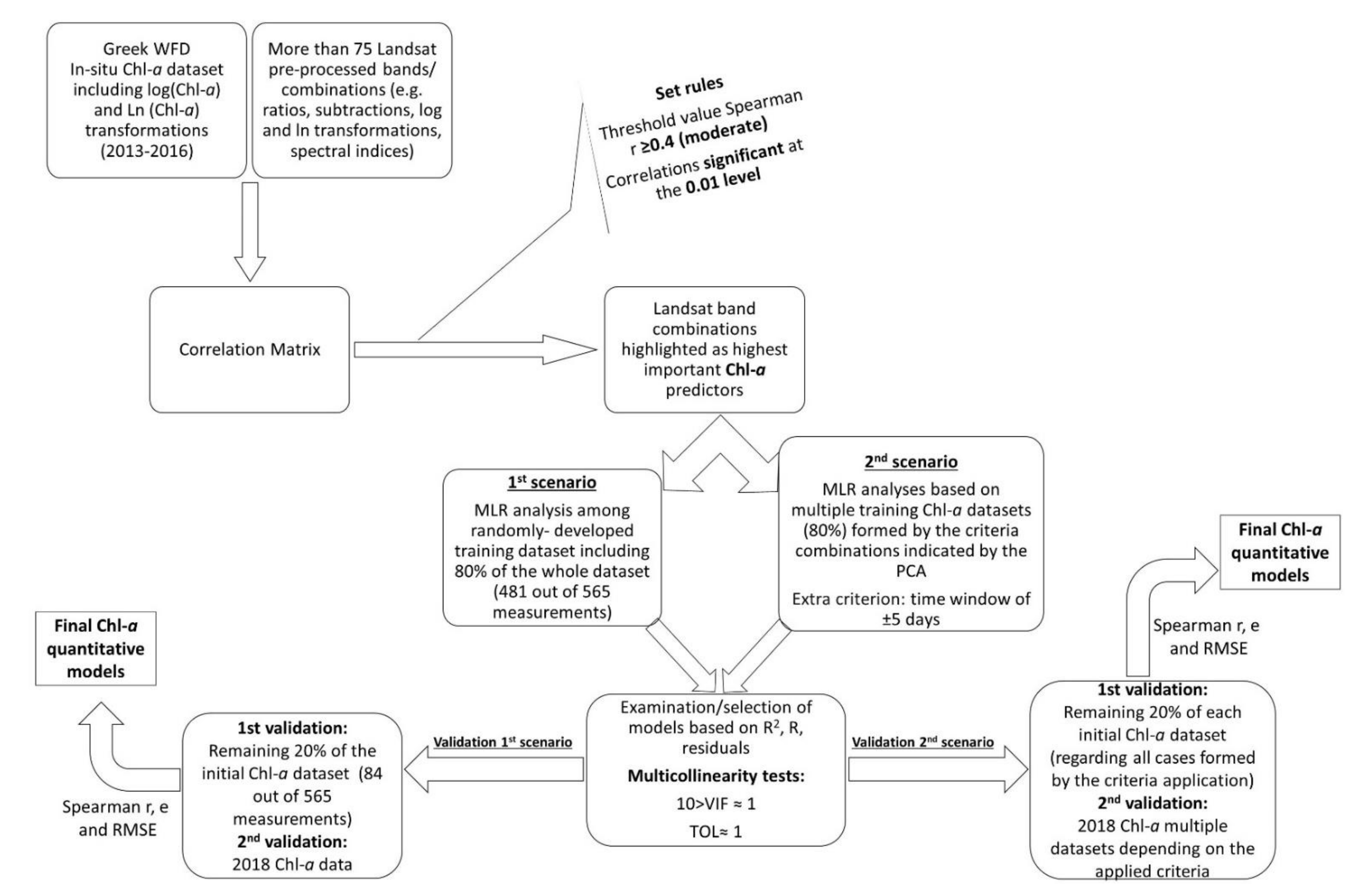
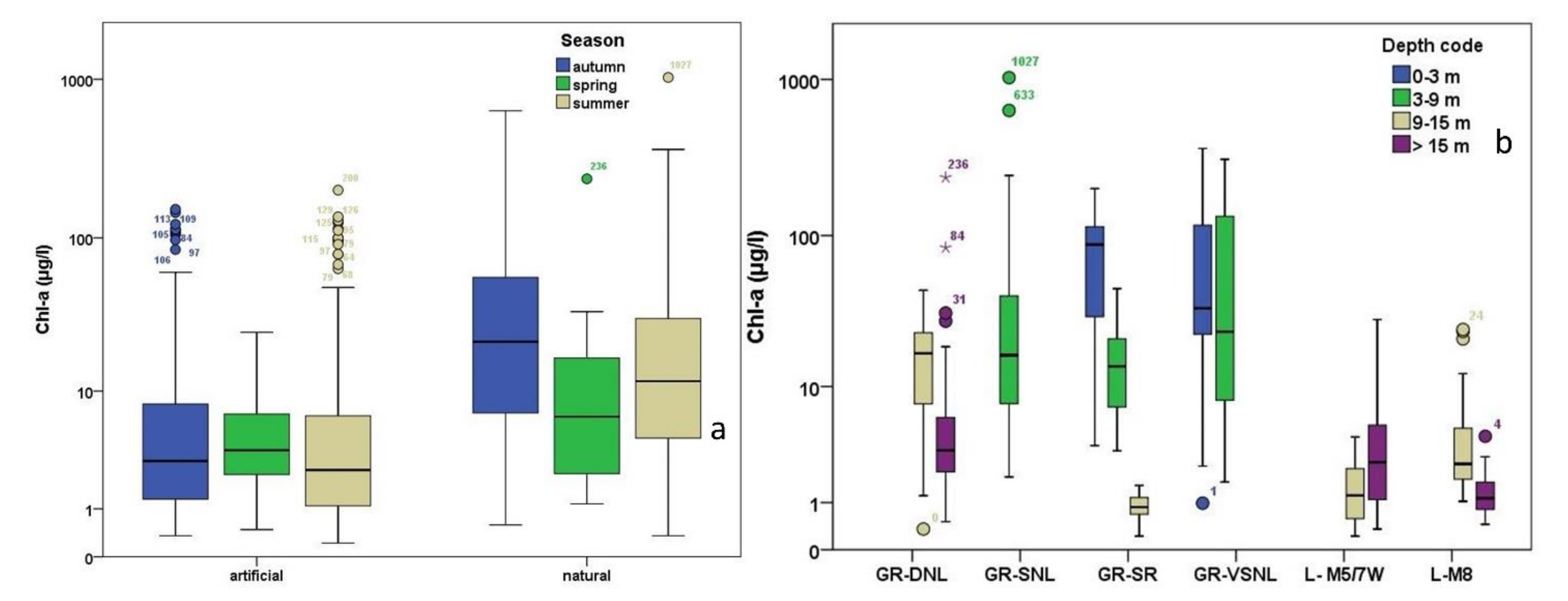
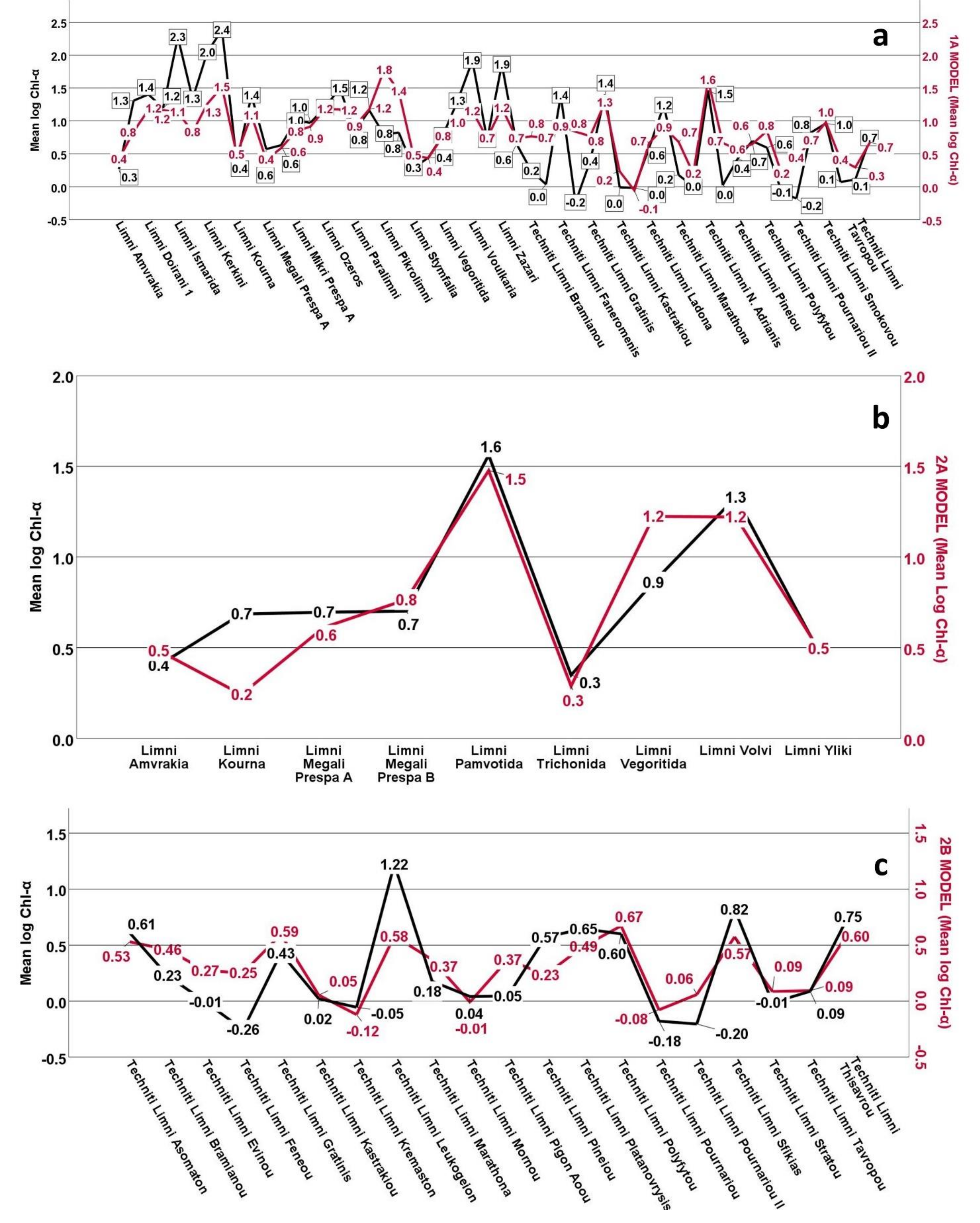
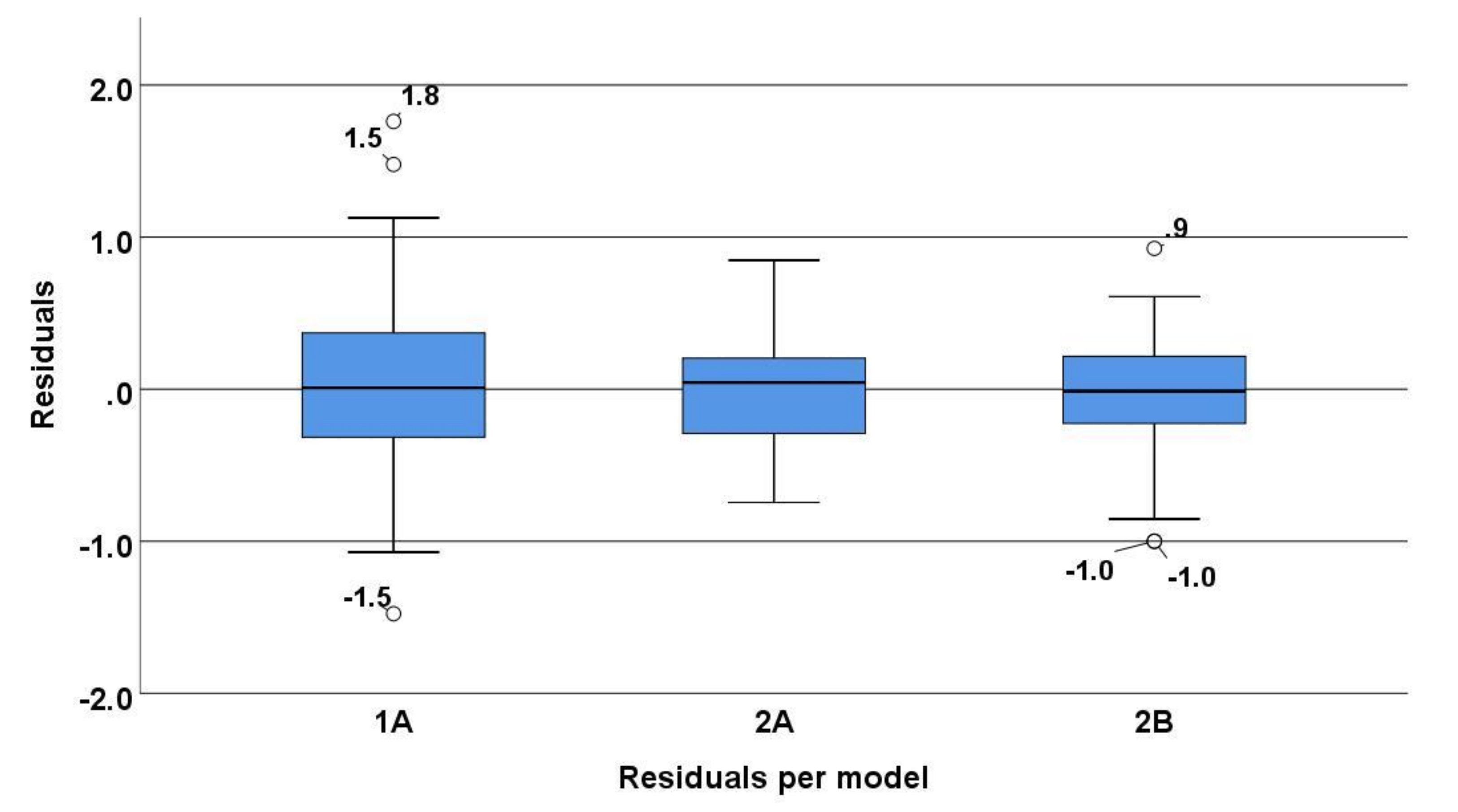
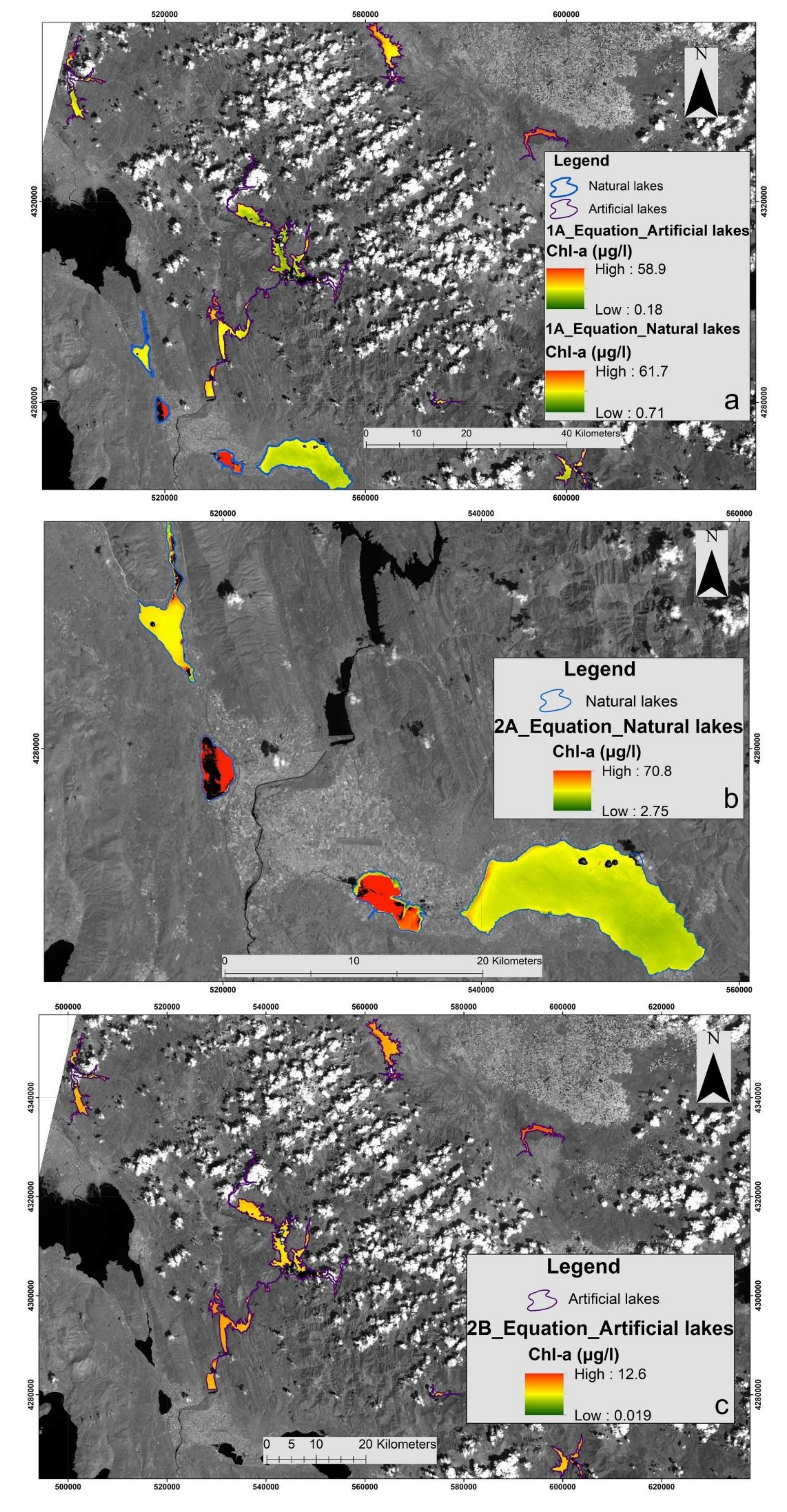
| No | National Name Station | Natural (N)/ Artificial (A) | Typology | Koppen Climate Classification | Mean Depth (m) | No | National Name Station | Natural (N)/ Artificial (A) | Typology | Koppen Climate Classification | Mean Depth (m) |
|---|---|---|---|---|---|---|---|---|---|---|---|
| 1 | Lake Ladona | A | L-M8 | Csa | - | 28 | Lake Petron | N | GR-VSNL | Cfa | 3.1 |
| 2 | Lake Pineiou | A | L-M8 | Csa | 15.1 | 29 | Lake Zazari | N | GR-SNL | Cfa | 3.95 |
| 3 | Lake Stymfalia | N | GR-VSNL | Csa | 1.31 | 30 | Lake Cheimaditida | N | GR-VSNL | Cfa | 1.01 |
| 4 | Lake Feneou | A | L- M5/7W | Csa | 10.5 | 31 | Lake Kastorias | N | GR-SNL | Cfa | 3.7 |
| 5 | Lake Kremaston | A | L-M8 | Csa | 47.2 | 32 | Lake Sfikias | A | L- M5/7W | BSk | 23.2 |
| 6 | Lake Kastrakiou | A | L- M5/7W | Csa | 33.2 | 33 | Lake Asomaton | A | L- M5/7W | BSk | 20.8 |
| 7 | Lake Stratou | A | GR-SR | Csa | 9.6 | 34 | Lake Polyfytou | A | L- M5/7W | Cfa | 22.4 |
| 8 | Lake Tavropou | A | L- M5/7W | Csa | 15.0 | 35 | Lake Mikri Prespa A | N | GR-SNL | Csa | 3.95 |
| 9 | Lake Lysimacheia | N | GR-SNL | Csa | 3.5 | 36 | Lake Mikri Prespa B | N | GR-DNL | Csa | - |
| 10 | Lake Ozeros | N | GR-SNL | Csa | 3.8 | 37 | Lake Megali Prespa A | N | GR-DNL | Csa | 17 |
| 11 | Lake Trichonida | N | GR-DNL | Csa | 29.6 | 38 | Lake Megali Prespa B | N | GR-DNL | Csa | - |
| 12 | Lake Amvrakia | N | GR-DNL | Csa | 23.4 | 39 | Lake Doirani 1 | N | GR-SNL | Dfc | 4.6 |
| 13 | Lake Voulkaria | N | GR-VSNL | Csa | 0.96 | 40 | Lake Doirani 2 | N | GR-SNL | Dfc | - |
| 14 | Lake Saltini | N | GR-SP1 (lagoon) | Csa | - | 41 | Lake Pikrolimni | N | GR-SP2 (special category) | Cfb | 1.2 |
| 15 | Lake Mornou | A | L- M5/7W | Csa | 38.5 | 42 | Lake Koroneia | N | GR-VSNL | Csa | 3.8 |
| 16 | Lake Evinou | A | L- M5/7W | Csa | 31.5 | 43 | Lake Volvi | N | GR-DNL | Csa | 12.3 |
| 17 | Lake Pigon Aoou | A | L- M5/7W | Csa | 20.8 | 44 | Lake Kerkini | A | GR-SR | Dfc | 2.19 |
| 18 | Lake Pournariou | A | L- M5/7W | Csa | 29.8 | 45 | Lake Leukogeion | A | GR-SR | Dfc | 4.05 |
| 19 | Lake Pamvotida | N | GR-SNL | Csa | 5.3 | 46 | Lake Ismarida | N | GR-VSNL | Csb | 0.9 |
| 20 | Lake Pournariou II | A | GR-SR | Csa | 11.7 | 47 | Lake Platanovrysis | A | L- M5/7W | Dfc | 26.4 |
| 21 | Lake Marathona | A | L-M8 | Csa | 15.8 | 48 | Lake Thisavrou | A | L- M5/7W | Dfc | 38.4 |
| 22 | Lake Dystos | N | GR-VSNL | Csa | - | 49 | Lake Gratinis | A | L- M5/7W | Csb | 14.2 |
| 23 | Lake Yliki | N | GR-DNL | Csa | 20.1 | 50 | Lake N. Adrianis | A | GR-SR | Csb | - |
| 24 | Lake Paralimni | N | GR-SNL | Csa | 2.99 | 51 | Lake Kourna | N | GR-DNL | Csa | 15 |
| 25 | Lake Karlas | A | GR-SR | BSk | 0.9 | 52 | Lake Bramianou | A | L-M8 | Csa | 10.1 |
| 26 | Lake Smokovou | A | L-M8 | Csa | - | 53 | Lake Faneromenis | A | L-M8 | Csa | 9.98 |
| 27 | Lake Vegoritida | N | GR-DNL | Dfa | 26.52 | 1 [31] | |||||
| Type | Characteristics | Elevation (m) | Precipitation (mm) and Temperature (°C) (Mean Annual Values) | Surface (km2) | Mean Depth (m) | Catchment (km2) | Thermal Stratification |
|---|---|---|---|---|---|---|---|
| Artificial | |||||||
| L- M5/7W | Deep, large reservoirs, silicate, wet areas | <1000 | >800 and/or <15 | >0.5 | >15 | <20000 | |
| L-M8 | Deep, large reservoirs, limestones | <1000 | - | >0.5 | >15 | <20000 | |
| GR-SR | Shallow reservoirs | <1000 | - | >0.5 | <15 | - | |
| Natural | |||||||
| GR-DNL | Deep lakes | 0–1000 | >0.5 | >9 | Thermal monomictic | ||
| GR-SNL | Shallow lakes | 0–1000 | >0.5 | 3-9 | Polymictic | ||
| GR-VSNL | Very shallow lakes | 0–1000 | >0.5 | <3 | Polymictic | ||
| Climate Type | Description |
|---|---|
| Csa | Mediterranean hot summer climates |
| Csb | Mediterranean warm/cool summer climates |
| Cfa | Humid subtropical climates |
| Cfb | Oceanic climate |
| Dfa | Hot summer continental climates |
| Dfc | Subarctic or boreal climates |
| BSk | Cold semi-arid climate |
| Chl-a (μg/L) 2013 | Chl-a (μg/L) 2014 | Chl-a (μg/L) 2015 | Chl-a (μg/L) 2016 | Chl-a (μg/L) 2018 | Chl-a (μg/L) all | |
|---|---|---|---|---|---|---|
| N | 157 | 155 | 172 | 82 | 136 | 702 |
| Minimum | 0.22 | 0.22 | 0.36 | 0.45 | 0.58 | 0.22 |
| Maximum | 263.9 | 1026.9 | 286.96 | 292.7 | 361.7 | 1026.9 |
| Mean | 24.44 | 29.13 | 23.06 | 27.99 | 27.03 | 26.06 |
| Standard Deviation | 46.94 | 101.82 | 46.27 | 45.34 | 55.92 | 64.31 |
| Skewness | 3.05 | 7.7 | 3.24 | 3.23 | 3.83 | 7.87 |
| Kurtosis | 9.7 | 67.8 | 11.7 | 14.1 | 16.9 | 97.5 |
| Component | Initial Eigenvalues | Extraction Sums of Squared Loadings | Rotation Sums of Squared Loadings | ||||||
|---|---|---|---|---|---|---|---|---|---|
| Total | % of Variance | Cumulative % | Total | % of Variance | Cumulative % | Total | % of Variance | Cumulative % | |
| 1 | 1.78 | 35.5 | 35.6 | 1.78 | 35.6 | 35.6 | 1.8 | 35.4 | 35.4 |
| 2 | 1.12 | 22.4 | 57.9 | 1.12 | 22.4 | 57.9 | 1.1 | 21.9 | 57.4 |
| 3 | 1.01 | 20.2 | 78.1 | 1.01 | 20.2 | 78.1 | 1.04 | 20.8 | 78.12 |
| 4 | 0.79 | 15.9 | 93.98 | ||||||
| 5 | 0.30 | 6.02 | 100 | ||||||
| Item | Component | ||
|---|---|---|---|
| 1 | 2 | 3 | |
| Sampling season | 0.25 | 0.75 | 0.26 |
| Chl-a (μg/L) | −0.31 | 0.73 | −0.23 |
| Natural/artificial | 0.9 | −0.03 | 0.06 |
| Köppen/climate type | −0.08 | 0.02 | 0.95 |
| Typology | 0.89 | 0.01 | −0.15 |
| Scenario/Model | R | R2 | Adjusted R2 | Std. Error of the Estimate | Change Statistics | Durbin–Watson | ||||
| R2 Change | F Change | df1 | df2 | Sig. F Change | ||||||
| 1A | 0.654 | 0.427 | 0.425 | 0.525 | 0.114 | 94.99 | 1 | 478 | 0.000 | 1.948 |
| Predictors: (Constant), blue/red, ln red/ln SWIR2 | ||||||||||
| No. of Case Regarding the Criteria Application | Combination of Criteria |
|---|---|
| 1 | Mean depth >5 m, natural lakes, all seasons |
| 2 | Mean depth >5 m, artificial lakes, all seasons |
| 3 | Mean depth >5 m, natural lakes, season spring |
| 4 | Mean depth >5 m, natural lakes, season autumn |
| 5 | Mean depth >5 m, natural lakes, season summer |
| 6 | Mean depth >5 m, artificial lakes, season spring |
| 7 | Mean depth >5 m, artificial lakes, season autumn |
| 8 | Mean depth >5 m, artificial lakes, season summer |
| 9 | Mean depth >5 m, season spring |
| 10 | Mean depth >5 m, season autumn |
| 11 | Mean depth >5 m, season summer |
| 12 | Mean depth >5 m, date difference (sampling/satellite): ±5 days |
| 13 | >3 m mean depth <15 m |
| Scenario/Model | R | R2 | Adjusted R2 | Std. Error of the Estimate | Change Statistics | Durbin–Watson | ||||
|---|---|---|---|---|---|---|---|---|---|---|
| R2 Change | F Change | df1 | df2 | Sig. F Change | ||||||
| 2A | 0.776 | 0.602 | 0.587 | 0.432 | 0.024 | 4.818 | 1 | 81 | 0.031 | 1.666 |
| 2B | 0.757 | 0.574 | 0.563 | 0.291 | −0.006 | 1.666 | 1 | 120 | 0.199 | 2.034 |
| 1st Validation (20%) | 2nd Validation (2018 Data) | |||||||||
|---|---|---|---|---|---|---|---|---|---|---|
| Scenario/ Models | Spearman r | Average In Situ log Chl-a | Average Satellite log Chl-a | Average Residuals | RMSE (log Chl-a/Chl-a; μg/L) | Spearman r | Average In Situ log Chl-a | Average Satellite log Chl-a | Average Residuals | RMSE(log Chl-a/Chl-a; μg/L) |
| 1A Training dataset N = 481 | 0.688** N = 84 | 0.79 | 0.76 | 0.03 | 0.29/1.95 | 0.758** N = 136 | 0.89 | 0.84 | 0.05 | 0.24/1.74 |
| 2A Training dataset N = 85 | 0.782** N = 21 | 0.85 | 0.83 | 0.02 | 0.095/1.25 | 0.697** N = 28 | 0.81 | 0.87 | −0.05 | 0.13/1.35 |
| 2B Training dataset N = 125 | 0.622** N = 31 | 0.197 | 0.237 | -0.04 | 0.1/1.26 | 0.593** N = 41 | 0.32 | 0.31 | 0.004 | 0.12/1.32 |
© 2020 by the authors. Licensee MDPI, Basel, Switzerland. This article is an open access article distributed under the terms and conditions of the Creative Commons Attribution (CC BY) license (http://creativecommons.org/licenses/by/4.0/).
Share and Cite
Markogianni, V.; Kalivas, D.; Petropoulos, G.P.; Dimitriou, E. Estimating Chlorophyll-a of Inland Water Bodies in Greece Based on Landsat Data. Remote Sens. 2020, 12, 2087. https://doi.org/10.3390/rs12132087
Markogianni V, Kalivas D, Petropoulos GP, Dimitriou E. Estimating Chlorophyll-a of Inland Water Bodies in Greece Based on Landsat Data. Remote Sensing. 2020; 12(13):2087. https://doi.org/10.3390/rs12132087
Chicago/Turabian StyleMarkogianni, Vassiliki, Dionissios Kalivas, George P. Petropoulos, and Elias Dimitriou. 2020. "Estimating Chlorophyll-a of Inland Water Bodies in Greece Based on Landsat Data" Remote Sensing 12, no. 13: 2087. https://doi.org/10.3390/rs12132087
APA StyleMarkogianni, V., Kalivas, D., Petropoulos, G. P., & Dimitriou, E. (2020). Estimating Chlorophyll-a of Inland Water Bodies in Greece Based on Landsat Data. Remote Sensing, 12(13), 2087. https://doi.org/10.3390/rs12132087







